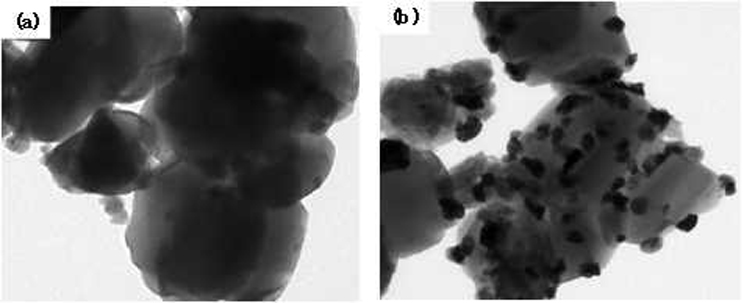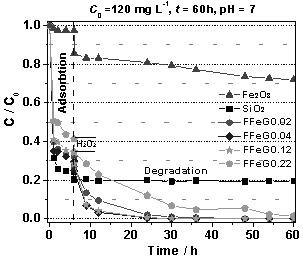A method for grinding-assisted self-infiltration synthesis of highly efficient catalytic degradation of methylene blue metal mesoporous silica
A mesoporous silica, catalytic degradation technology, applied in chemical instruments and methods, non-metallic elements, oxidized water/sewage treatment, etc., to achieve the effects of excellent adsorption/catalytic performance, fewer species, and excellent cycle stability
- Summary
- Abstract
- Description
- Claims
- Application Information
AI Technical Summary
Problems solved by technology
Method used
Image
Examples
Embodiment 1
[0032] S1. Dissolve 2.0g of triblock copolymer P123 as a template in 75g of water, stir until completely dissolved, add 2.41g of aluminum chloride hexahydrate, and place the mixture in a water bath at 35°C for 0.5h;
[0033] S2. Using tetraethyl orthosilicate as the silicon source, the addition amount is 4.16g, and stirred for 24h in a water bath at 35°C;
[0034] S3. Pour the mixed solution in S2 into an autoclave for hydrothermal aging at 100°C for 24 hours, filter, wash with deionized water, repeat twice, and dry naturally to obtain mesoporous silica containing a template;
[0035] S4. Weigh 0.6g of mesoporous silicon oxide prepared in step S3, add 0.0162g of anhydrous ferric chloride, grind and mix, add 2 drops of absolute ethanol dropwise during the grinding process, the grinding time is 35min, and then In the furnace, the temperature was first raised to 200°C at a rate of 6°C / min, and kept for 30 minutes, then raised to 550°C at a rate of 2°C / min, kept for 300 minutes, a...
Embodiment 2
[0040] S1. Dissolve 2.0g of triblock copolymer P123 as a template in 75g of water, stir until completely dissolved, add 2.41g of aluminum chloride hexahydrate, and place the mixture in a water bath at 35°C for 1 hour;
[0041] S2. Using tetraethyl orthosilicate as the silicon source, the addition amount is 4.16g, and stirred for 24h under the condition of 35°C water bath;
[0042] S3. Pour the mixed solution in S2 into a high-pressure reactor for hydrothermal aging at 100°C for 24 hours, filter, wash with deionized water, repeat 3 times, and dry naturally to obtain mesoporous silica containing a template;
[0043] S4. Weigh 0.6g of mesoporous silicon oxide prepared in step S3, add 0.0162g of anhydrous ferric chloride, grind and mix, add 3 drops of absolute ethanol dropwise during the grinding process, the grinding time is 35min, and then In the furnace, the temperature was first raised to 200°C at a rate of 6°C / min, kept for 30 minutes, then raised to 550°C at a rate of 2°C / mi...
Embodiment 3
[0049] S1. Dissolve 2.0g of triblock copolymer P123 as a template in 75g of water, stir until completely dissolved, add 2.41g of aluminum chloride hexahydrate, and place the mixture in a water bath at 35°C for 0.5h;
[0050] S2. Using tetraethyl orthosilicate as the silicon source, the addition amount is 4.16g, and stirred for 24h under the condition of 35°C water bath;
[0051] S3. Pour the mixed solution in S2 into an autoclave for hydrothermal aging at 100°C for 24 hours, filter, wash with deionized water, repeat twice, and dry naturally to obtain mesoporous silica containing a template;
[0052] S4. Weigh 0.6g of mesoporous silicon oxide prepared in step S3, add 0.0811g of anhydrous ferric chloride, grind and mix, add 3 drops of absolute ethanol dropwise during the grinding process, the grinding time is 28min, and then In the furnace, the temperature was first raised to 200°C at a rate of 6°C / min, kept for 30 minutes, then raised to 550°C at a rate of 2°C / min, kept for 300...
PUM
| Property | Measurement | Unit |
|---|---|---|
| concentration | aaaaa | aaaaa |
Abstract
Description
Claims
Application Information
 Login to View More
Login to View More - R&D
- Intellectual Property
- Life Sciences
- Materials
- Tech Scout
- Unparalleled Data Quality
- Higher Quality Content
- 60% Fewer Hallucinations
Browse by: Latest US Patents, China's latest patents, Technical Efficacy Thesaurus, Application Domain, Technology Topic, Popular Technical Reports.
© 2025 PatSnap. All rights reserved.Legal|Privacy policy|Modern Slavery Act Transparency Statement|Sitemap|About US| Contact US: help@patsnap.com



